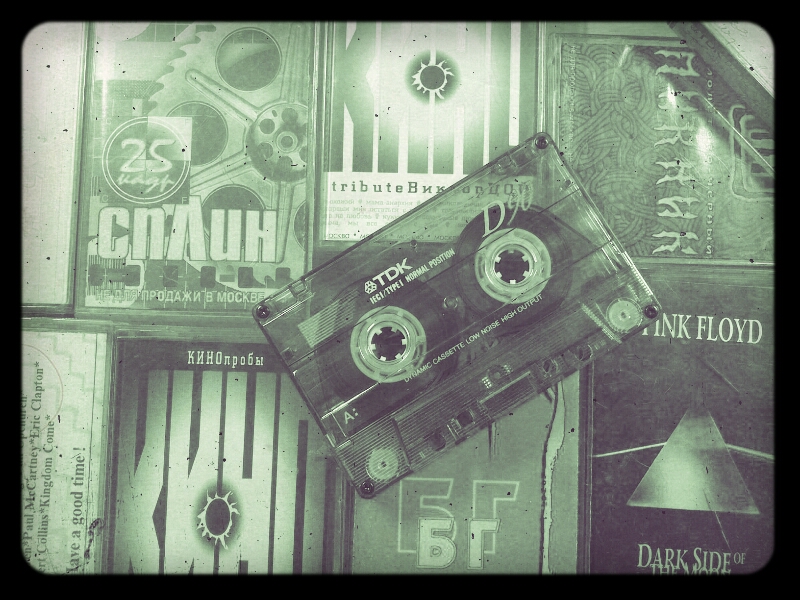From cassettes to online streaming

Recently, while cleaning the house, I found a box with old audio cassettes. Here it is, in the photo. I specifically applied the effect of lomography to emphasize the feelings that this find has caused me.
In this article, I would like to recall with what we listened to music, what were the players, and at the same time and fantasize about the direction of their evolution.
Cassette
I remember at the end of the 90s I went to school with a cassette player, and in computer magazines I saw an ad for mysterious devices — MP3 players. Unfortunately, the player I have not survived, I only remember that it was a Chinese thing with a proud Walkman inscription. Of course, this device was a little less than a true Walkman.
The cassettes were 45 minutes each, 60 each, and even 90 each on one side. But branded, so-called “licensed” tapes contained only one album, and the party there could even last 30 minutes. If you wanted to be able to listen to something else, you had to carry a lot of cassettes with you in your backpack. It was not possible to quickly find the desired composition - I hope it is clear why. To this it is worthwhile to add a periodic zazhivanie film. And with what appetite this player “ate” the batteries - I don't even want to remember.
In general, I will not say that listening to music was easy.
')
CDs
At about the same time there were already players playing CDs, but they seemed to me much more inconvenient than cassette ones, since the player itself and the disks to it took up quite a lot of space. Some advantages could be noticed if the device could not play regular CDs, but MP3s. But still: the size of the CD player is slightly larger than the size of the disc, and the size of the cassette player is slightly larger than the tape. Therefore, cassette players still seemed to me more compact.
By the way, the 120-mm optical discs are called compact because they were not yet 30-cm compact. Fortunately, they are not widely spread.
Flash
After graduating from school, I bought my first MP3 player with a memory capacity (scary to say!) 256 MB. To understand how “many” this is, it’s enough to remember that a CD (a regular CD, not a DVD, and certainly not Blue-Ray) fit 600 MB, which was almost 10 hours of MP3 sound. This player “eaten” the battery is not as active as a cassette one, but it was necessary to charge the batteries every three to four days.
Later, buying a phone with a 3.5 mm jack, I thought that here it is, the perfect player. But there were some unexpected problems. If you pull out the headphones from the phone, then he suddenly switched to an external speaker, and everyone around you knew what you were listening to. In terms of dimensions, the phone was significantly larger than the MP3 player, and its interface is still focused on calls and SMS, and not on managing the track list.
And the replacement of cassettes has nowhere to go, except that now it was to connect the player to the computer via USB and record the necessary compositions there.
As a result, I wore a telephone and a player at the same time for a long time, until a two-hour tram trip disappeared from my life.
Online
Whatever device for listening to music, we choose, we can not get away from the finite volume of the memory card. No matter how big it is, but all the music that I would like to listen to will not fit there.
The obvious property of the perfect player is the absence of the need to download new music. That is, your entire music collection should always be available. It is clear that no information carrier is enough, and he is not needed. Cloud technologies will help us.
Such a solution is already there - ASUS Cloud . Of course, there is a client for Android devices . That is, you can download a collection of music there and with a rather quick internet connection, listen to it online.
Future
It seems to me that specialized devices for listening to music online should appear one day. And although the market of pocket players almost completely supplanted smartphones, there is another niche - car radio. How do you like this tape recorder that can play any tune from your collection? All that is needed for this is a sim card and a fairly fast mobile Internet.
Further more. The need for local storage of music may soon exhaust itself. There will be services that allow you to create a playlist of songs directly on the server, and provide streaming broadcasting. Something like personal internet radio.
The pros are obvious. The consumer has no need to upload gigabytes of files to the device with the expectation that one of these things suddenly wants to listen. It will be easy to share music with friends and find out what they are listening to.
Of the minuses, we can note a new stage in the development of the struggle for copyrights. But bulletproof servers, traffic encryption and free licenses will come to the rescue, under which they will post entries.
The only problem that has been relevant since the days of cassette players to this day is how to fold the headphones so that they do not get confused?
Source: https://habr.com/ru/post/158893/
All Articles